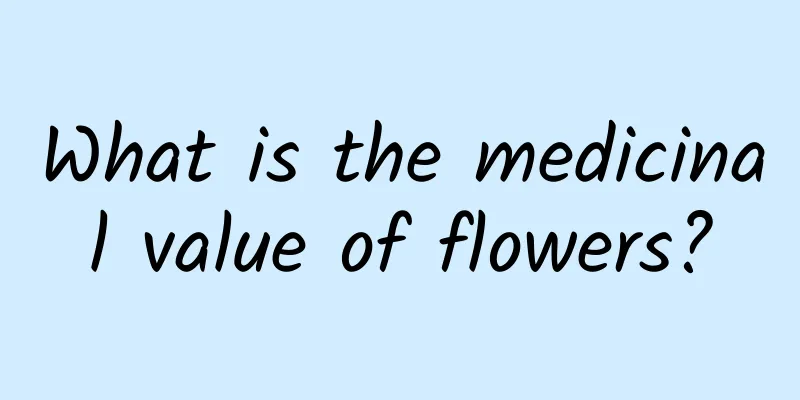What is the medicinal value of flowers?

|
Everyone likes beautiful flowers very much, because flowers can give us a visual feast and make us feel relaxed and happy, and some flowers can emit very fragrant smells, which are very beautiful embellishments in our lives. The most important thing is that there are many types of flowers, different flowers have different colors and smells, and the medicinal value is also completely different. Catharanthus roseus: a perennial herbaceous flower of the Apocynaceae family. The plant is about 60 cm tall, with single leaves arranged alternately, oblong or nearly obovate; the flowers are axillary, purple or red. The whole plant is used as medicine, containing more than seventy kinds of biological alkaloids, such as vinblastine and vincristine, which have the effects of calming the nerves, dispersing nodules and fighting cancer. Used to treat leukemia, breast cancer, ovarian cancer, lymphoma, etc. It likes to grow on beaches, near villages, and in grass beside roadsides. It is mainly produced in Guangdong, Guangxi and Yunnan. Impatiens: An annual herbaceous flower of the Impatiens family, the plant is about one meter tall, with fleshy stems; the leaves are alternate, lanceolate; the flowers are solitary or clustered in leaf axils, with single or double petals, pink or variegated. The whole plant is used as medicine and contains saponins and other ingredients. It has the effects of promoting blood circulation, dispersing blood stasis, softening hard masses and fighting cancer. Used to treat esophageal cancer and gastric cancer. It often grows in shady and wet places near villages and roadsides. It can also be cultivated for viewing. Cycad: An evergreen tree of the Cycadaceae family. The plant is two to three meters tall, with a straight cylindrical stem densely covered with persistent leaf bases and leaf scars; the leaves are clustered at the top of the stem, and the pinnate leaves are dark green and shiny; the plant is dioecious, with a cylindrical, yellow male inflorescence and a ballpoint pen-shaped female flower; the seeds are scarlet when ripe. The leaves are used as medicine and contain biflavonoid chemicals - cycadinol, cycadinol, neocycadinol A and B. It has the effects of astringency, hemostasis, detoxification and anti-cancer. Used to treat cervical cancer, etc. It is distributed in the wild in Fujian and Guangdong. It can be cultivated for viewing in all places. Red Lycoris: a perennial herbaceous flower of the Amaryllidaceae family. It has a bulb that is shaped like an onion; the leaves are basal, fleshy, ribbon-shaped, blue-green with white; the peduncle is solitary, with terminal umbels and bright red flowers. The bulb is used as medicine, containing various alkaloids, such as lycorine, lycorineamine, galantamine, etc. It has the effects of dispelling wind, reducing swelling, detoxifying and fighting cancer. Used to treat gastric cancer, esophageal cancer, liver cancer, and tried to treat lung cancer, ovarian cancer, cervical cancer, and lymphoma. It often grows in mountains, jungles, and shady and wet places by rivers, and is distributed from the Yangtze River basin to the southwest and south China. It can also be cultivated for viewing. Milkweed: a perennial herb and flower of the Amaryllis family. With latex, simple leaves are opposite, lanceolate or rectangular-lanceolate; umbels are terminal or axillary, corolla is whorled with five deep lobes, red, and corona is yellow. The whole plant is used as medicine, containing guanylin, and the leaves and flowers show alkaloid reactions. It has the effects of reducing fire, relieving pain, stopping bleeding and fighting cancer. Used to treat gastric cancer, intestinal cancer, uterine cancer, and kidney cancer. It often grows in wilderness and river valley wetlands. Distributed in the southeastern and southern regions of my country. It can also be cultivated for viewing. To sum up, we have learned about the medicinal value of flowers. This depends on the type of flowers. The more common vinca roseus can be used directly to treat leukemia, or cancers such as breast cancer, and it also has certain calming and sedative effects. |
>>: What are the effects and functions of Poria cocos
Recommend
What are the medicinal values of snake tongue grass
Snake tongue grass has umbrella-shaped white flow...
The efficacy and function of plum thorn fruit
Plum thorn fruit is a traditional Chinese medicin...
The "murderer" that once caused mass extinction of biological species, will its "shadow" reappear on Earth in the future?
Tuchong Creative Everyone may have a personal exp...
The efficacy and function of Artemisia sphaerocephala
Many people choose Artemisia selengensis because ...
The efficacy and function of Cangshan fir
I believe many people are familiar with the Chine...
The efficacy and function of Vitex quinata
The medical value of Vitex quinata is beyond our ...
What are the effects and functions of the king flower?
When it comes to Queen of the Night, many people ...
The efficacy and function of the white juice from the stem of the genus Euphorbia
The white juice from the stem of the genus Euphor...
Effects of Danshen Hawthorn Panax Notoginseng Powder
In daily life, we find that many people are not v...
The efficacy and function of Brassica
Do you know what Brassica is? If you know, do you...
The efficacy and function of Pseudoindigofera flexu
Indigofera flexuosa is one of the common traditio...
The efficacy and function of the big arrow ball
Dayijianqiu is a medicinal material frequently us...
Snatching cell phones, picking backpacks... There are more conflicts between monkeys and humans, and it’s not just the monkeys’ fault
"Attention, tourists! If you bring glasses, ...
Side effects of processed Chuanwu
Many people are not particularly familiar with pr...
Barnard 68, mistakenly thought to be a black hole, is actually a mass...
Author: Huang Xianghong Duan Yuechu There are man...









